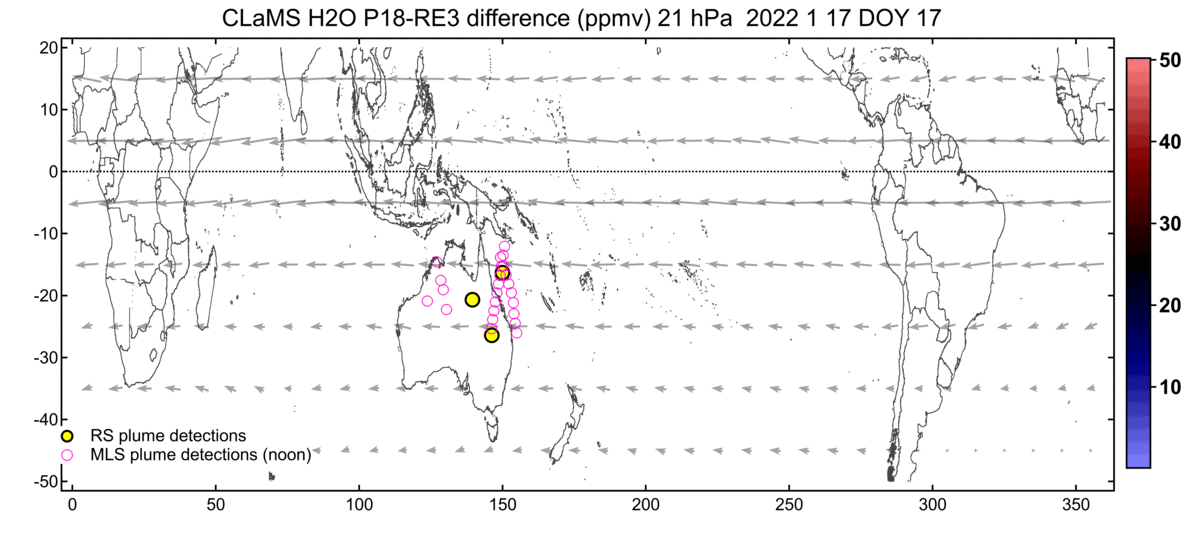Hunga Tonga eruption: the most remarkable climatic event in the last three decades
Published in Earth & Environment

Major volcanic eruptions are well known drivers of sudden climate change. The wealth of sulfur, injected into the stratosphere by highly explosive eruptions, condenses into submicron aerosol droplets – sulfate aerosols. These aerosols reflect the solar radiation back to space, which leads to cooling of the surface climate by more than one degree for several years and deplete the ozone layer. This was the case for the previous major eruption of Mt Pinatubo in 1991, ranked the volcanic explosivity index (VEI) of 6. The eruption of the submarine volcano Hunga Tonga Hunga Ha’apai on 15 January 2022 was ranked VEI 5.7 because of its extreme explosiveness, estimated at 110 Mt in TNT equivalent, which is twice the largest nuclear explosion ever undertaken. The explosion generated tsunamis propagating tens thousands kilometers and atmospheric waves propagating surface-to-space.
A collaborative study led by Sergey Khaykin, a researcher at LATMOS/UVSQ, describes the evolution of this event and its repercussions on the global composition of the stratosphere. The study, relying on collaboration between five French CNRS laboratories and 12 institutions across the World, uses of a large suite of various satellite sensors together with over 30 ground stations and transport model simulation to cover a broad range of temporal and spatial scales of this event – from minutes and kilometers to yearly and global scales.
The study shows that during the eruption, the vaporized seawater and sulfur contained in the volcano’s magmatic chamber has been spewed high into the atmosphere and reached unprecedented altitude of 58 km. The mass of injected water is estimated at 146±5 Mt, which - given the ascent rate of the eruptive column of 40 m/s - translates into the flux of water comparable with the discharge of Amazon river. In about four hours, the volcanic cloud grew to the size of Germany and, carried by strong winds in the stratosphere, circumnavigated the Earth in only one week.
A chemistry-transport model simulation using FZG Julich CLaMS model, enabled an accurate reconstruction of the volcanic plume evolution The volcanic material has then spread nearly pole-to-pole in about three months, thereby perturbing the stratospheric gaseous and aerosol composition at global scale.

The study shows that in addition to a 5-fold increase in the stratospheric aerosol burden, largest in the last three decades, the Hunga eruption let to an unprecedented increase in the global stratospheric water mass by 13%. Without efficient sinks of moisture in the stratosphere, the ample hydration of this atmospheric layer is expected to persist for years. Given the magnitude, the depth and the expected longevity of the stratospheric perturbation, the Hunga eruption can be said to have initiated a new era in stratospheric gaseous chemistry and particle microphysics with a wide range of potential long-lasting repercussions for the global stratospheric composition and dynamics. The various observations used in this study pave the way to uncovering the climate-altering capacity of this extraordinary volcanic event, which, unlike the other major eruptions, is expected to warm the surface climate due to greenhouse effect of the stratosphere hydration.
While the longer-term aftermath of the Hunga effects is yet to be known, the available data provide enough evidence to rank this eruption among the most remarkable climatic events in the modern observational era. As remote sensing techniques and satellite coverage of the stratosphere have been substantially improved in the XXI century, the wealth of observational data on the Hunga should provide a major advance in understanding the impacts of stratospheric composition change on global climate.
Follow the Topic
-
Communications Earth & Environment

An open access journal from Nature Portfolio that publishes high-quality research, reviews and commentary in the Earth, environmental and planetary sciences.
Related Collections
With Collections, you can get published faster and increase your visibility.
Geology of the Moon
Publishing Model: Hybrid
Deadline: Jan 31, 2026
Archaeology & Environment
Publishing Model: Hybrid
Deadline: Mar 31, 2026

Please sign in or register for FREE
If you are a registered user on Research Communities by Springer Nature, please sign in